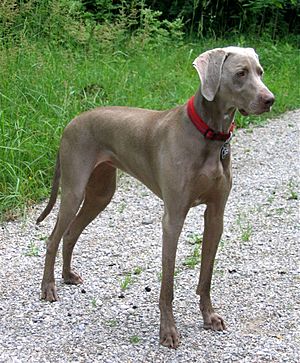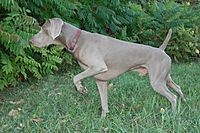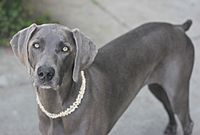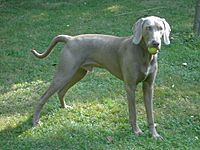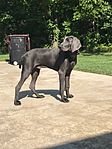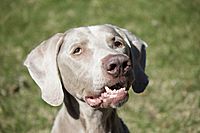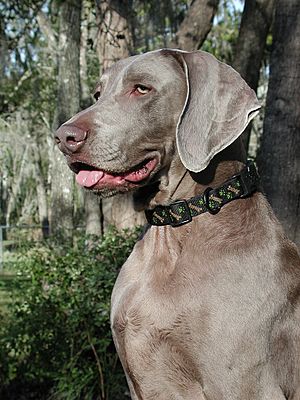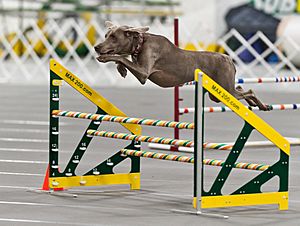Weimaraner facts for kids
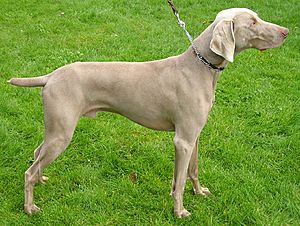
Male Weimaraner with docked tail
|
|||||||||||||||||||||
| Common nicknames | Raner
Weim "Gray Ghost" |
||||||||||||||||||||
|---|---|---|---|---|---|---|---|---|---|---|---|---|---|---|---|---|---|---|---|---|---|
| Origin | Germany | ||||||||||||||||||||
|
|||||||||||||||||||||
|
|||||||||||||||||||||
| Domestic dog (Canis lupus familiaris) | |||||||||||||||||||||
The Weimaraner ( VY-mə-rah-nər) is a large dog breed. It was first bred for hunting in the early 1800s. These dogs were used by royalty to hunt big animals like boars, bears, and deer.
As hunting big game became less popular, Weimaraners started hunting smaller animals. These included fowl, rabbits, and foxes. The Weimaraner is a great all-around gun dog. Its name comes from Karl August, the Grand Duke of Saxe-Weimar-Eisenach. His court in the city of Weimar (in Germany) loved hunting.
Weimaraners are known for their speed, strength, and excellent sense of smell. They also have great eyesight, courage, and intelligence. People sometimes call them the "gray ghost" because of their unique coat color and quiet hunting style.
Contents
History of the Weimaraner
The Weimaraner was kept by the Weimar court in the 1800s. These dogs had a lot of Leithound in their family tree. Some people think they came from Chien-gris dogs. Others believe they are related to the St. Hubert Hound, which is an ancestor of the Bloodhound.
At first, Grand Duke Karl August used Weimaraners to hunt large animals. These included wolves, bears, and mountain lions. But as the number of big game animals in Europe went down, the Weimaraner's job changed. They became dogs that would point to small game and then bring it back.
The breed came to America in the late 1920s. Its popularity grew a lot in the 1950s. Famous people like Grace Kelly, President Dwight D. Eisenhower, and Dick Clark helped make them popular. The artist and photographer William Wegman made them even more famous. He created many well-known portraits and videos with his Weimaraners.
About the Weimaraner
What Weimaraners Look Like
Weimaraners have a strong, athletic look. Traditionally, their tails are shortened, a process called docking. In places where this is still allowed, the adult dog's tail should be about 6 inches long. This is part of the American Kennel Club (AKC) breed rules.
However, tail docking is against the law in many countries. In these places, Weimaraners are shown with their full tails. The British Kennel Club says the tail should reach the hocks (a joint on the back leg) and hang low when the dog is relaxed. The German breed club wants a full, strong tail that can be carried high when the dog is working. Weimaraners are also great water dogs because they have webbed paws.
Their eyes can be light amber, grey, or blue-grey.
Coat and Color
This breed has a short coat and unusual eyes. This gives them a special, noble appearance. Their coat is very easy to care for. It is short, tough, and smooth to touch. The color can be charcoal-blue, mouse-grey, silver-grey, or even blue-grey. Where the fur is thin, like inside the ears, the skin should look pinkish.
Weimaraners do not have an undercoat. This means they can get cold easily, so they should avoid very cold weather. Even though their coat is short, this breed does shed hair.
The United Kennel Club (UKC) now recognizes both Blue and Longhair Weimaraners. However, a black coat is still not allowed. A small white mark on the chest is okay. Dogs with blue coats cannot compete in AKC shows. But the AKC still recognizes them as purebred Weimaraners.
There's another rare type of Weimaraner called "mark of the hound." These dogs are the usual grey color but have faint tan marks. These marks are similar to those on Doberman Pinschers. Weimaraners can also have unique features. These include small folds inside the ear called "Harrasburg Horns." They can also have very light grey patches between the ears called "Grafmar's Caps."
A long-haired Weimaraner is recognized by most dog clubs around the world. But the American Kennel Club does not recognize it. The long-haired Weimaraner has a silky coat and a full, feathery tail. The gene for long hair is recessive. This means that long-haired puppies will only be born if both parents carry this gene.
Size
According to the Fédération Cynologique Internationale (FCI) rules, male Weimaraners are usually between 59 to 70 cm (23 to 28 in) tall at the withers (the highest part of the back at the base of the neck). Females are between 57 to 65 cm (22 to 26 in) tall.
Males typically weigh about 30–40 kg (66–88 lb). Females are usually between 25–35 kg (55–77 lb). A Weimaraner should always look like a strong, athletic dog.
Weimaraner Temperament
The Weimaraner is a very energetic hunting dog. It is known for its physical strength and endurance. It has a strong natural urge to hunt. A Weimaraner might get along with cats, but often it won't. It tends to follow its hunting instinct. It will likely chase and kill any small animal that comes into the yard.
A Weimaraner needs a lot of exercise. It will love games and playtime. An owner who is active will be able to give the dog the strong exercise and games it needs. Weimaraners also need proper training to learn how to be calm and control their behavior.
As a Hunting Dog
Weimaraners have a lot of energy that needs to be used up. They are excellent hunting dogs. They are great at hunting, tracking, pointing, and bringing back game. They can do this both on land and in water.
The Weimaraner is a very people-oriented breed. They really want to work and live with their owners. This makes them a good choice for someone new to hunting. They need a gentle touch when being trained to hunt. They often learn best from an experienced hunting dog.
Behavior Challenges
Weimaraners are not independent dogs. They love to be with their owners and do not like to be left alone. This can lead to very strong separation anxiety. We don't always know why separation anxiety happens. But things like genetics, how they were raised as puppies, not enough social time, boredom, and stress can play a role.
Weimaraners with severe separation anxiety might destroy things or hurt themselves trying to escape. Good training can help reduce some of this anxiety. A Weimaraner with separation anxiety might bark, whine, howl, or even dig until its owner comes home. Other signs of this problem can include panicking, drooling a lot, destructive actions, and getting hurt.
Weimaraner Health
According to the Orthopedic Foundation for Animals, Weimaraners have low rates of hip dysplasia. This is a condition where the hip joint doesn't form correctly. The breed is ranked 102nd out of 153 breeds. Many Weimaraners are tested, and a high percentage get excellent ratings. It's usually a good idea to get a Weimaraner from breeders who test their dogs' hips. They use methods like OFA or PennHIP.
Weimaraners are deep-chested dogs. This means they are prone to bloat or gastric torsion. This is a very serious condition that can cause painful and quick death if not treated. It happens when the stomach twists. This cuts off blood vessels and stops food from moving in or out. Signs include general distress, discomfort, no bowel movements or sounds, and a swollen stomach. If bloat happens, you need to get medical help right away. Surgery is the only option if it's caught early enough.
One way to help prevent bloat is to feed your Weimaraner at least twice a day. Also, avoid strong exercise an hour before or after meals. It's also suggested that the dog's food dish not be on a raised platform. This helps stop them from eating too quickly and swallowing air. Raised food bowls have been found to more than double the risk of bloat in large dogs.
Skin allergies are common in Weimaraners. You should see a vet if your dog starts losing hair, itching all the time, or getting rashes. Parasites can cause an allergic reaction, along with the usual irritation from bites.
Other health issues that can affect Weimaraners include:
- Cryptorchidism (undescended testicles)
- Distichiasis (extra eyelashes)
- Elbow dysplasia (a problem with the elbow joint)
- Entropion (eyelid rolling inward)
- Pituitary dwarfism (being much smaller than normal)
- Hypertrophic osteodystrophy (a bone growth problem)
- Hypomyelinogenesis (a nerve problem)
- Hypothyroidism (underactive thyroid gland)
- Progressive retinal atrophy (an eye disease that can lead to blindness)
- Renal dysplasia (kidney problem)
- Von Willebrands Disease (a blood clotting disorder)
Images for kids
-
Grand Duke Karl August of Weimar
See also
 In Spanish: Braco de Weimar para niños
In Spanish: Braco de Weimar para niños



